| Join | Official Historian | City of Stamford | Blog | About Us | |
| Jewish Historical Society | Civil War Roundtable | Contact Us | |
|
|
|
|
The Stamford Historical Society PresentsPortrait of a Family: Stamford through the Legacy of the Davenports
John Davenport 1669–1730/31“He was not over careful of pleasing Men, John Davenport, born in Boston in 1669, was baptized by his grandfather, John Davenport, founder of New Haven Colony. He graduated from Harvard College in 1687 and began preaching in 1690. Three years later he was called to the Stamford church as an assistant to the ageing minister, John Bishop. His terms of call included seventy pounds a year while Bishop lived, then to be raised to one hundred pounds thereafter. He was also to receive an allotment of firewood and various other considerations once he was married and raising a family. Following his ordination in 1694, John married Martha Gould Selleck, widow of John Selleck, in 1695. Together they had seven children. When Martha died in 1712, her death was greatly lamented by the community by whom she was held in great affection. Davenport then married Elizabeth Morris Maltby. They had two sons, Abraham and James. Davenport’s training and background in the ministry especially qualified him for his work in Stamford and his position in the community was renowned for wisdom and discretion. As his congregation grew, the church was enlarged and then rebuilt. In 1699 a pair of Quakers visited Stamford and began to preach despite reservations on the part of the town constable and first selectman. They then traveled to Fairfield where a number of the county’s clergy were meeting, including John Davenport. Attempting to speak after services, Davenport called for authorities to remove them. Afterwards they met with the clergy, where they held a somewhat heated debate. During this deliberation Davenport was reported to have “changed colours, grew very red, though naturally pale.” Eventually their discussions ended civilly, with one of the Quakers remembering that they took “them kindly by the hands, and they with us.” Davenport was commended in 1703 by the General Assembly of Connecticut for the opportunity to preach the election sermon, a singular honor given to clergy well into the nineteenth century. In the early 18th century, numerous quarrels between ministers and their congregations elevated to a point where the need was clear for the formation of an association that could act as an arbitrator, enabling decisions through a set of rules. In 1708, at the direction of the General Assembly, a Synod consisting of twelve ministers and four laymen convened at Saybrook. Highly regarded as a scholar of biblical languages, John Davenport made significant contributions towards the preparation of the famous Saybrook Platform. In 1710 the results of their deliberations were published in a work titled: A Confession Of Faith: Owned and Consented to by the Elders and Messengers Of the Churches In the Colony of Connecticut in New-England, the first book to be published in Connecticut. Approved by the General Assembly, this work resulted in unifying official procedures within the church; a directive that continued to be utilized well into the next century. It was Davenport who led the successful removal of the College from Saybrook to New Haven. For twenty-four years he was a member of the corporation of Yale College At the first commencement at New Haven, in September of 1718, he made an oration in Latin at Yale College, extolling the generosity of Elihu Yale for whom the institution had been named. He continued to zealously preach in Stamford. Towards the end of his life he became very concerned regarding “that Crime in particular … Intemperance in Drink, and what is the Fore-runner and Concomitant of it, Tavern Haunting.” John Davenport died in February 1730/31 and was interred in the old burying ground near the center of downtown Stamford. Greatly esteemed by his church, community and throughout the Colony of Connecticut, the loss of this man was widely observed. In the sermon delivered by the Reverend Samuel Cooke of Stratfield at his funeral it was stated that “It was many Years since lookt upon by the serious and judicious as a special Favour of Divine Providence, that a Person of such Distinction …. was seated so near the Western Limits of New England, as a Bulwark against any Irruptions of corrupt Doctrines and Manners.” On display in the exhibit: Necessarius : the continuance of an able and Godly minister very needful to a people : a sermon preached at the funeral of the Reverend Mr. John Davenport, late Pastor of the church in Stamford : who died on Fryday, Febr. 5, 1730-1, in the 62 year of his age, and 36 of his ministry : and was decently interred on Munday following.
From the seventeenth century well into the twentieth, when a noted member of the community died, it was customary for the minister to deliver a funeral sermon. Often the deceased’s family printed and distributed them as mementos. Prior to the establishment of a press in Stamford in 1829, anything that needed to be printed was taken to Boston, New Haven or New York. The funeral sermon for the Rev. John Davenport was produced from the press of John Peter Zenger of New York. Zenger’s press is noteworthy, because in 1735, the Colony of New York brought Zenger to trial for criminal libel. Acquitted by a jury, this was the first primary triumph for freedom of the press in the American colonies. Courtesy The New Haven Colony Historical Society Digital Reproduction of Silver Communion Cup of 1880
Courtesy of The First Congregational Church of Stamford
Digital Reproduction of Stained Glass Windows First Congregational Church of Stamford The window depicting the angel Michael is in memoriam of Reverend John Davenport, 1669-1731, third pastor of the church, 1694-1731. The window depicting the angel Gabriel is in memoriam of the Davenport family. These windows were given by Judge Charles Davenport Lockwood and other members of the Davenport family. The windows were designed by the Montague Castle-London Company of New York City and executed in English antique glass.
Courtesy of The First Congregational Church of Stamford North Stamford
The church, the third meeting house on this spot, was built in 1872 in the style of “a typical New England Congregationalist church.” C. Bartram Hartman, was born in Junction City, Kansas and studied at the Art Institute of Chicago, the Royal Academy in Munich, and in Paris. The style of many of his paintings suggests early modernism influenced by Fauvism, a style characteristic of a group of French artists in the early 20th century. Lent by Laurel & Francis Cooley Also on display: Winter Scene, North Stamford Congregational Church |
|||||||
|
|
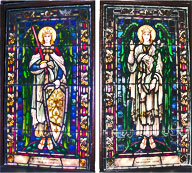
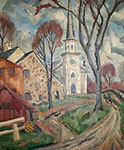
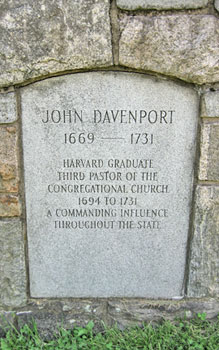
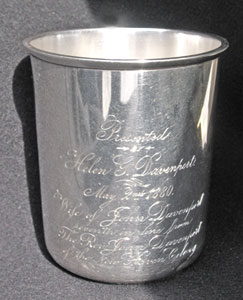
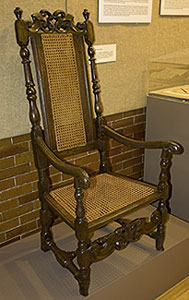
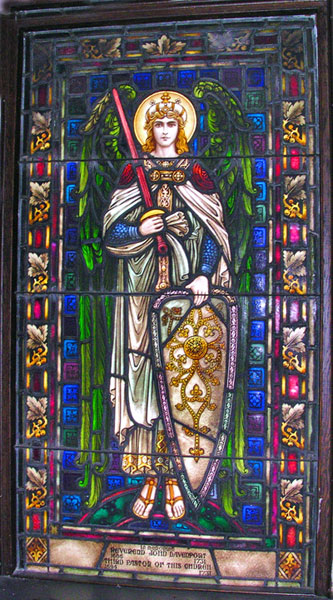
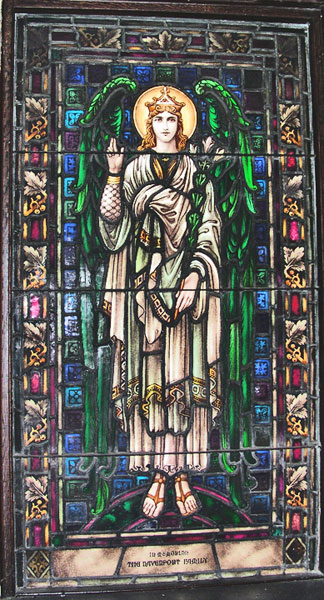
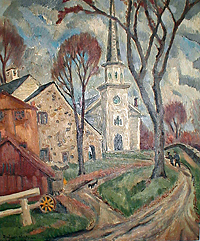 The North Stamford Congregational Church sits on the crest of a hill rising above the late 18th and early 19th century homes and outbuildings lining the one-street village of North Stamford, Connecticut. The blacksmith shop in the foreground is no longer standing. The stone and wood building behind it is the Community House, begun in 1925 by Henry Lockwood in memory of Helen M. Davenport Lockwood, his wife. Mr. Lockwood died before the building was completed, so his son, Judge Charles Davenport Lockwood, completed the building in memory of both parents. It stands on the site of a one-room schoolhouse that was moved to the rear of the meeting house, and now serves as the Guild House.
The North Stamford Congregational Church sits on the crest of a hill rising above the late 18th and early 19th century homes and outbuildings lining the one-street village of North Stamford, Connecticut. The blacksmith shop in the foreground is no longer standing. The stone and wood building behind it is the Community House, begun in 1925 by Henry Lockwood in memory of Helen M. Davenport Lockwood, his wife. Mr. Lockwood died before the building was completed, so his son, Judge Charles Davenport Lockwood, completed the building in memory of both parents. It stands on the site of a one-room schoolhouse that was moved to the rear of the meeting house, and now serves as the Guild House.